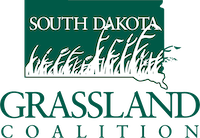The following tips will be helpful in designing your own grazing plan with a goal of creating healthy pastures:
- The reason rotational grazing creates healthier pastures is the time allowed for plants to recover after being bit by livestock.
- Rest can be much different than recovery. Recovery is rest during the growing season. Rest is simply the amount of time cattle are off the pasture.
- Managing plant recovery is one key to successful pasture management.
- It’s important to note, plants do not recover during extreme drought and winter.
- Recovery time varies greatly between soil types and rainfall amounts. Grass plants in a loamy soil east river with high rainfall will recover much faster than a low rainfall clay soil west river.
Some guidelines: During a pasture rotation when do I re-graze a pasture?
1) In a native plant mix, grazing the plants once during the growing season will encourage both warm and cool season plants to move to a healthier state. If your goal is to increase plant diversity, then one time through a pasture/growing season is almost always more productive longterm. The focus here is plant recovery.
Example: A ranch near Chamberlain leaves 1500#/acre in their rotation with a goal of increasing plant diversity. In this case, 14 months rest is optimal for pasture health.
2) If your goal is to maintain a cool season monoculture, such as brome or crested wheat grass, rainfall will determine whether a second graze during the growing season will be positive longterm.
Example: A ranch near Corsica is rotating through brome grass pastures one time during the growing season because rainfall did not support a second graze. In this case, 10-14 months rest/ recovery is optimal for pasture health. A second graze during the growing season should only be done if it will maintain or improve soil health.
The key is to learn to work with nature. This is done by observing what is happening in the pasture. Then adapting your management plan to improve pasture health.
In conclusion
Rotational grazing over time creates healthy soil leading to healthy pastures. This may require a change in the ranch management model and even a change in the ranch culture. Making healthy soil a priority will pay for years to come. The Grassland Coalition Grazing Schools teaches land managers how to create healthy pastures. Go to sdgrass.org for more information. Look for “Creating Healthy Pastures-Part 3” in the next issue of Grassroots.
Source: SDGC Newsletter
